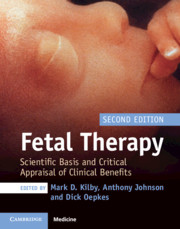Book contents
- Fetal Therapy
- Fetal Therapy
- Copyright page
- Dedication
- Contents
- Contributors
- Foreword
- Section 1: General Principles
- Section 2: Fetal Disease: Pathogenesis and Treatment
- Red Cell Alloimmunization
- Structural Heart Disease in the Fetus
- Fetal Dysrhythmias
- Manipulation of Fetal Amniotic Fluid Volume
- Fetal Infections
- Fetal Growth and Well-being
- Preterm Birth of the Singleton and Multiple Pregnancy
- Complications of Monochorionic Multiple Pregnancy: Twin-to-Twin Transfusion Syndrome
- Complications of Monochorionic Multiple Pregnancy: Fetal Growth Restriction in Monochorionic Twins
- Complications of Monochorionic Multiple Pregnancy: Twin Reversed Arterial Perfusion Sequence
- Complications of Monochorionic Multiple Pregnancy: Multifetal Reduction in Multiple Pregnancy
- Chapter 39 Fetal Reduction and Selective Termination
- Chapter 40 Selective Termination of One Fetus in Monochorionic Twin Pregnancies
- Fetal Urinary Tract Obstruction
- Pleural Effusion and Pulmonary Pathology
- Surgical Correction of Neural Tube Anomalies
- Fetal Tumors
- Congenital Diaphragmatic Hernia
- Fetal Stem Cell Transplantation
- Gene Therapy
- Section III: The Future
- Index
- References
Chapter 40 - Selective Termination of One Fetus in Monochorionic Twin Pregnancies
from Complications of Monochorionic Multiple Pregnancy: Multifetal Reduction in Multiple Pregnancy
Published online by Cambridge University Press: 21 October 2019
- Fetal Therapy
- Fetal Therapy
- Copyright page
- Dedication
- Contents
- Contributors
- Foreword
- Section 1: General Principles
- Section 2: Fetal Disease: Pathogenesis and Treatment
- Red Cell Alloimmunization
- Structural Heart Disease in the Fetus
- Fetal Dysrhythmias
- Manipulation of Fetal Amniotic Fluid Volume
- Fetal Infections
- Fetal Growth and Well-being
- Preterm Birth of the Singleton and Multiple Pregnancy
- Complications of Monochorionic Multiple Pregnancy: Twin-to-Twin Transfusion Syndrome
- Complications of Monochorionic Multiple Pregnancy: Fetal Growth Restriction in Monochorionic Twins
- Complications of Monochorionic Multiple Pregnancy: Twin Reversed Arterial Perfusion Sequence
- Complications of Monochorionic Multiple Pregnancy: Multifetal Reduction in Multiple Pregnancy
- Chapter 39 Fetal Reduction and Selective Termination
- Chapter 40 Selective Termination of One Fetus in Monochorionic Twin Pregnancies
- Fetal Urinary Tract Obstruction
- Pleural Effusion and Pulmonary Pathology
- Surgical Correction of Neural Tube Anomalies
- Fetal Tumors
- Congenital Diaphragmatic Hernia
- Fetal Stem Cell Transplantation
- Gene Therapy
- Section III: The Future
- Index
- References
Summary
Monochorionic (MC) twin pregnancy is associated with special complications that are unique to the shared placenta and vascular anastomoses. These complications include twin-to-twin transfusion syndrome (TTTS), selective fetal growth restriction (sFGR), twin reverse arterial perfusion sequence (TRAPS), twin anemia-polycythemia sequence (TAPS), and conjoined twins [1]. Furthermore, the incidence of discordant structural anomalies is more common in MC twins (6–8%) than in dichorionic (DC) twins (1–2%). In these conditions, selective reduction of one of the MC twins may have to be considered to maximize the chance of survival of the co-twin, or to minimize the risk to it. Unlike DC twin pregnancies in which their placentas have no vascular anastomoses, MC twins are connected via multiple vascular channels between their fused placenta [2]. Therefore, intracardiac KCl injection is not a feasible option in MC twin pregnancies [3]. Hence selective reduction must aim specifically at stopping the target twin’s umbilical blood flow, either at the umbilical cord level, or at the intra-abdominal portion of its vessels just beneath its insertion site (intrafetal), using more sophisticated methods. In this chapter, various indications and different surgical methods of selective reduction, as well as the comparison between the methods, are discussed.
- Type
- Chapter
- Information
- Fetal TherapyScientific Basis and Critical Appraisal of Clinical Benefits, pp. 418 - 425Publisher: Cambridge University PressPrint publication year: 2020
References
- 1
- Cited by

